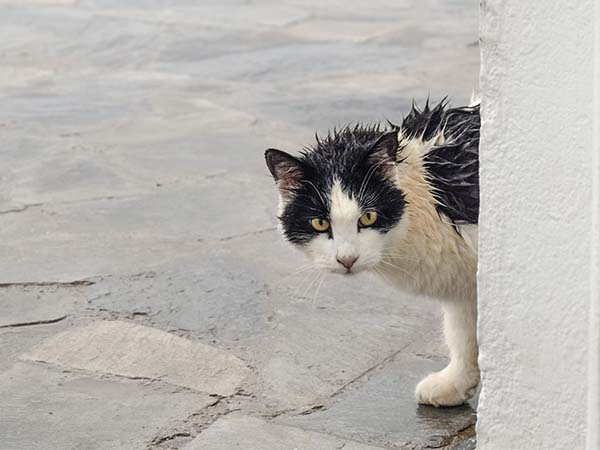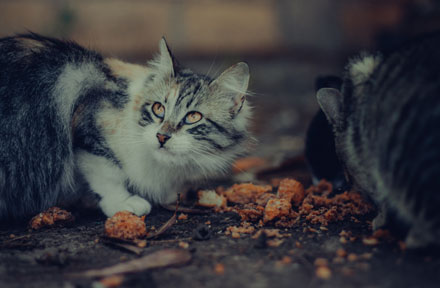-
Home
-
Shop
New -
Explore
-
Support
-
Track Order
Feb 03, 2023
Author:Jackson Watson
Splashing through puddles, pool fun, or getting eager over bath time are not activities typically associated with cats. Have you ever wondered why are cats afraid of water and avoid going in the water?
In this post, we’re going to discuss the reasons why cats are afraid of water and how you can teach your cat to love water.
Cats have a complex relationship with water and most cats prefer to stay dry
A cat’s strong sense of smell also explains why cats are afraid of water. Our feline companions are particularly sensitive to the chemicals found in water. Even though we might not be able to detect them, the chemicals in the water give it a particular odor that a cat’s sensitive nose will pick up straight away. The fluoride in tap water may not bother us but it may be unpleasant for cats.

A cat’s sense of smell is almost 14 times better than that of humans. Their nose contains almost 200 million olfactory receptors while humans have roughly 5 million. This makes them very sensitive to the chemicals in tap water. When they get wet, they don’t enjoy the odors and smells lingering through their groomed coats.
Do you know that just one negative experience about water can turn your cat off water for good? Some cats develop an anti-water attitude because they might have had a bad experience with water.
Sometimes, these traumatic first interactions can help explain the mystery of why cats are afraid of water. If being submerged in the water was a negative experience the first few times, it’s likely a “no way” at the sight of the water well into a cat’s adult years.
Most cats have coats that can trap water. When a cat gets wet, its coat is heavier and colder, and they become uncomfortable and feel at a disadvantage.
When cats’ entire fur gets drenched, they will feel weighed down and unable to walk at their normal levels. That’s quite a stressful and uncomfortable experience for a kitty that likes to navigate life with an effortless gait.

Another reason why cats are scared of water is attributed to their history. There is not much in the domestic cat’s ancestors’ past to prepare them for water.
As the Middle East has a dry desert climate, domestic cats’ ancestors were rarely exposed to rain and water bodies like lakes and rivers. So, all other water, besides the drinking water, was unfamiliar to them.
Cats are nimble creatures, light-footed, and adept at jumping and balancing. They aren’t as agile in water as they’re on land. Cats’ coats aren’t water-resistant and they feel less safe in the water, as they aren’t as agile.
When entering the water, they may feel a lack of control as it slows them down. Being on a wet surface with water going down on their coat, and weighing them down is enough to make their instincts go haywire.

Water is essential for a cat’s health. The majority of cats don’t like water but you can desensitize a cat to water. Let’s learn how to teach your cat to love water.
Put your cat in an empty bathtub and play with their favorite toy. This can be tricky but a good starting point is to get all the essentials right.

If your cat has a fear of water, start with extremely small exposures. Go at your cat’s pace to avoid any setbacks. Remember, the goal is that your cat likes the water – not that you force your cat into the water. Forcing them before they are ready can make them more afraid. With ample time and effort, there is a way.
Be patient and don’t drench your cat all at once. Let your cat dip their paws in the water and get comfortable. Slowly let their tail dip down into the water and then move on with the body.

Keep the experience positive so that your cat doesn’t become afraid of water. When teaching your cat to love water, bring with you plenty of treats or some familiar toys to soothe them. Make it a really positive experience by bringing some delicious treats that your cat loves.
Use toys, treats, and positive reinforcement techniques to make it a good experience. Remember that petting, praises, and kind words combined with a delicious treat become a powerful tool.
Temperature also affects how your cat feels about water. So, water should be warmed before introducing the cat to it.
Cats generally follow the instincts of their ancestors in the wild. They have evolved to prefer clean and safe moving water over stagnant water. A cat’s instincts consider moving water as more likely to be fresh and safe than still water.
Flowing freshwater is what felines enjoy most. So, the still water in the cat water bowl will be ignored. The solution is to simply invest in a WOpet cat water fountain that will keep the water moving, filtered, and fresh. The water fountain is a good way to get your cat interested in water. It helps to encourage your cat to drink more and drink safely.

A cat water fountain ensures that your cat has access to enough water and will never suffer from dehydration. Your cat can fulfill their thirst even if you’re out of the house for a period of time.
Cats are usually fascinated by running water and it stimulates the cat’s strong prey drive. This is most likely due to the movement of the water, the noise it makes, and the reflection that moving water makes.
They may also feel more at ease when playing with the water fountain because they’re in control and safely on dry land.
Popular Post

Why Does My Cat Cough After Drinking Water? 8 Potential Reasons
Mar 13, 2023

My Cat Only Eats A Little at A Time - What to Do?
Feb 27, 2023

What to Feed a Sick Dog With No Appetite? [2024 Guide]
May 16, 2023

Why Is My Dog Being Destructive All of A Sudden?
Feb 04, 2023

Do Puppies Miss Their Moms
Feb 11, 2023
Copyright © 2024 WOPET. All Rights Reserved.